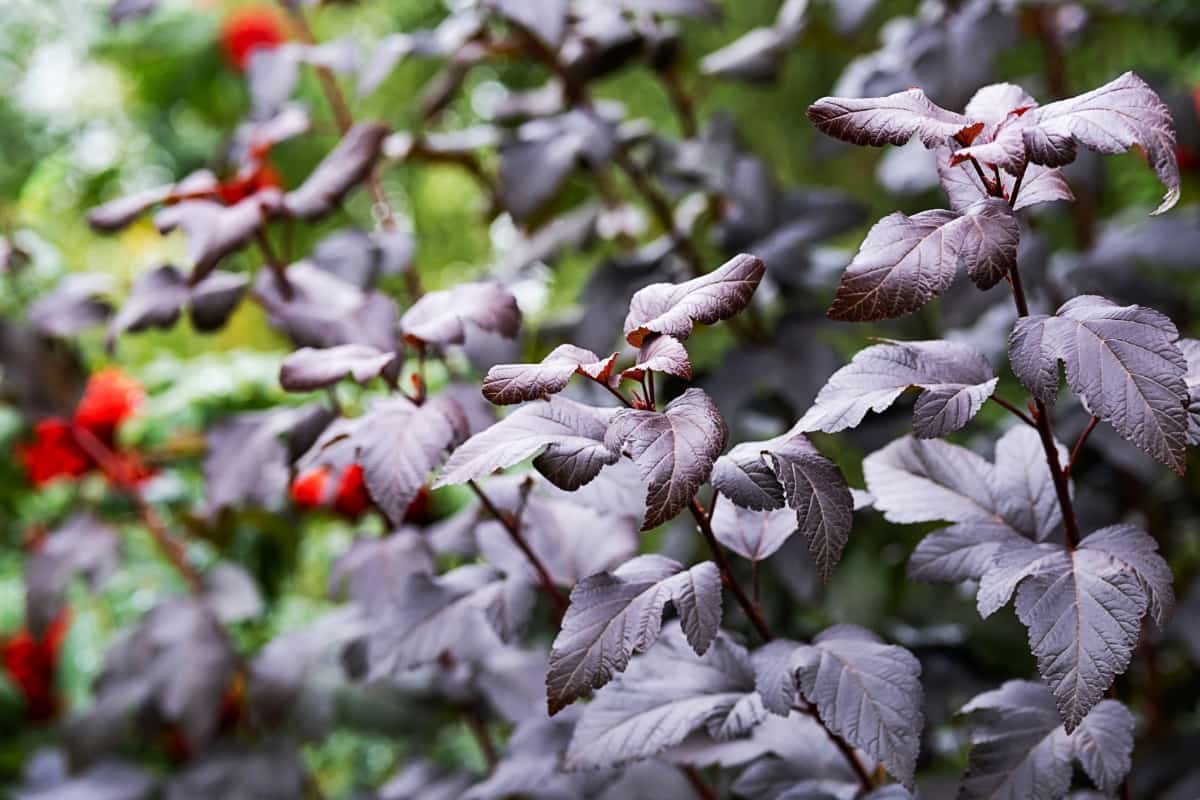Ninebark shrubs are popular for gardeners looking to add beauty and interest to their landscapes. These versatile shrubs are known for their attractive foliage, stunning flowers, and colorful bark. Ninebark shrub native to eastern North America. When it comes to ninebark shrub size, it grows up to 3-10 feet in height and 3-12 feet wide. If you’re thinking of adding nine-bark shrubs to your garden, here’s a guide on how to grow and care for ninebark shrubs.

How to Plant and Care of Ninebark Shrubs
How to Choose the Best Ninebark Shrubs for Your Garden
Once you have assessed your garden’s requirements, familiarize yourself with the different ninebark shrub varieties available. Some popular options include,
- Summer Wine Ninebark: This variety features deep burgundy foliage, making it an excellent option for adding a touch of drama to your garden
- Diabolo: Known for its stunning deep purple leaves, this variety is highly sought after for its eye-catching color.
- Dart’s Gold: If you prefer a shrub with golden foliage, ‘Dart’s Gold’ is a great option. Its vibrant leaves can brighten up any garden space.
- Coppertina: This variety displays coppery-red foliage that matures to a rich purple shade, providing a unique visual appeal.
Tips for Growing Ninebark Shrubs in Different Climates
Provide Optimal Sunlight
- Ninebark sun or shade? Ninebark shrubs generally prefer full sun to partial shade.
- In hot climates, provide some afternoon shade to protect the shrubs from intense heat, especially during the peak summer months.
- In cooler climates, ensure the shrubs receive adequate sunlight to promote healthy growth and flowering.
Watering And Irrigation
- While Ninebark shrubs are drought-tolerant once established, they will benefit from watering regularly during the first year.
- Deep and infrequent watering in hot and dry climates encourages deep root growth.
- Adjust watering frequency to prevent waterlogging and root rot in cooler and wetter climates.
Pruning Techniques for Maintaining Healthy Ninebark Shrubs
What is the growth rate of Ninebark? Ninebark is a fast-growing shrub and can see height increases of 2 feet a single year. Ninebark should be pruned after it flowers, or no later than mid-August, to maintain its shape and improve air circulation. Pruning can be done by cutting one-third of the branches, focusing on older and damaged branches and those that cross and rub. Older shrubs can be radically pruned close to the ground before winter for better leaf and flower growth in the spring. Pruning ninebark usually results in a strong recovery.
The Importance of Soil Preparation for Successful Ninebark Shrub Growth
One of the primary reasons why soil preparation is important for Ninebark shrub growth is because it helps improve drainage. Ninebark shrubs prefer well-drained soil, as excessive moisture can cause root rot and other diseases. By loosening the soil and incorporating organic matter, you can enhance its drainage capabilities, preventing water from pooling around the roots and causing damage.
Watering Requirements and Irrigation Methods for Ninebark Shrubs
Watering Requirements
- Soil Moisture: Check the soil’s moisture level around shrubs before watering. Your finger should be inserted up to the second knuckle in the soil. When the soil feels dry at this depth, it’s time to water.
- Frequency: Ninebark shrubs require regular watering, especially during their establishment period. Watering should be done deeply and infrequently. Wait until the soil is slightly dry out between waterings.
Irrigation Methods
- Hand Watering: Use a hose with a gentle spray nozzle or a watering can to apply water directly to the base of the shrubs. Ensure the water reaches the root zone, but avoid excessively wetting the foliage.
- Drip Irrigation: Install a drip irrigation system with emitters near each shrub’s base. This method helps minimize water wastage and ensures that the water is delivered precisely where needed.
- Soaker Hoses: These porous hoses release water slowly and evenly along their entire length, allowing deep penetration into the soil. Place the soaker hoses around the shrubs, ensuring they adequately cover the root zone.
In case you missed it: How to Grow Woody Plants in Containers: A Step-By-Step Guide

Common Pests and Diseases that Affect Ninebark Shrubs and How to Prevent Them
You can keep ninebark shrubs free of aphids by spraying them with a steady stream of water to flush out the pests or misting them with neem oil. With proper upkeep, established Ninebark shrubs are free of most problems. Fireblight, leaf spots, and powdery mildew may occur but are rarely fatal. Badly damaged branches can be pruned away to avoid most diseases.
Best Companion Plants to Pair With Ninebark Shrubs in the Garden
Grow Ninebark as a foundation shrub where it won’t grow to block a window or walkway. Give it enough space to grow in its naturally arching branch pattern for the best look. In a mixed shrub border, grow Ninebark with other deciduous shrubs, such as lilac and spirea. Use different colored ninebarks in the back of a perennial flower border to show off the brightly colored perennials such as coneflowers and bee balm.
How to Propagate Ninebark Shrubs from Cuttings or Seeds
- Gather your pruning shears, rooting hormone, a zippered plastic bag, and sphagnum moss or wood shavings.
- Cut several pieces of hardwood branches (not softwood tips) from your shrub in late fall or early winter. Make cuts about 1/2 inch thick and 4 to 6 inches long. Each cutting should have at least two nodes.
- Dip the bottom of each cutting in the rooting hormone. Gather the cuttings together and secure them with a rubber band.
- Place the bundled cuttings in a plastic bag with slightly moist sphagnum moss or wood shavings. Store the cuttings in the refrigerator to keep them dormant.
- When the ground can be worked in early spring, separate the bundled cuttings and plant them in the soil, ensuring the tops are facing up. Bury them so that all but the top nodes are below ground.
- Water the cuttings regularly. They will need a full growing season to develop roots, but your fully rooted cutting will mature in late fall or early spring.
Seasonal Care and Maintenance Tasks for Thriving Ninebark Shrubs
Spring Care
- Pruning: Remove any dead or damaged branches to promote healthy growth.
- Fertilizing: Apply a slow-release fertilizer to provide essential nutrients.
Summer Care
- Watering: Ensure your Ninebark shrubs receive adequate water, especially during dry spells.
- Monitor for pests: Watch for common pests like aphids or spider mites. If needed, apply appropriate insecticides or organic pest control methods.
Winter Care
- Monitor moisture levels: Ensure the soil is not too dry or soggy.
- Shield from heavy snow: Shake off or gently remove heavy snow from the branches to prevent breakage.
Creating a Beautiful Landscape Design Using Ninebark Shrubs as Focal Points
Designing with Ninebark Shrubs: Once you have determined the ideal location for your Ninebark shrubs, it’s time to plan their placement in your landscape design. Consider the following design tips to create a visually stunning outdoor space:
Create A Focal Point: Place a Ninebark shrub in a prominent location, such as the center of a flower bed or at the end of a pathway. Its vibrant foliage and peeling bark will immediately draw attention and add visual interest.
Grouping For Impact: Choose cultivars with contrasting foliage colors to create a dynamic visual effect.
Contrast With Other Plants: Pair Ninebark shrubs with plants that have different textures, colors, and growth habits to create a visually pleasing contrast.
Create Depth And Layers: Use Ninebark shrubs to create depth and layers in your landscape design. Place taller varieties towards the back of a flower bed or border and shorter varieties towards the front.
In case you missed it: Tree, Houseplant, and Shrub Fertilizer Spikes: Everything You Need to Know About

Conclusion
In your garden, you can successfully grow and care for Ninebark shrubs by following these tips. With their beautiful foliage, attractive flowers, and interesting bark, these shrubs will surely enhance your landscape’s overall beauty and appeal.
- Ultimate Guide to Ossabaw Island Hog: Breeding, Raising, Diet, and Care
- Ultimate Guide to Juliana Pig: Raising Facts, Size, Diet, Care, and Lifespan
- Raising Lleyn Sheep: Disadvantages, Price, Uses, Characteristics, and Care
- Ultimate Guide to Meishan Pig: Breed Facts, Breeding, Raising, and Care
- Ultimate Guide to Teacup Pigs: Raising, Diet, Lifespan, Cost, and Care
- Guide to Raising Poll Dorset Sheep: Facts, Profile, Characteristics, Uses, and Care
- Ultimate Guide to Bighorn Sheep: Characteristics, Diet, Lifespan, Breeding, and Lifecycle
- Ultimate Guide to Raising Katahdin Sheep: Farming Facts, Breed Profile, Uses, and Care
- Ultimate Guide to Raising Oreo Cows: Belted Galloways Farming Facts, Profile, Uses, and Care